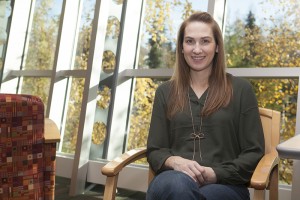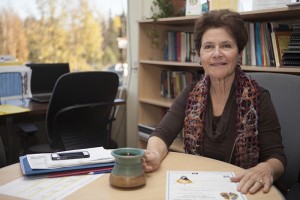Untangling the problem of affordable housing
by Tracy Kalytiak |
Last November, Lindsey Blumenstein was skimming slips of paper posted on a bulletin board when she spotted the perfect job: UAA was searching for an assistant professor who would teach criminal justice courses and delve into research on domestic violence and sexual assault.

Dr. Lindsey Blumenstein is one of many people who have faced challenges finding an affordable place to live in Anchorage. (Photo by Philip Hall/University of Alaska Anchorage)
There was one hitch. If Blumenstein received and accepted a job offer, she'd have to leave her home state of Florida and find a new home more than 4,000 miles away.
"I thought, it's an adventure, I'm 30, I've never left Florida. It's time," said Blumenstein, who began working at the UAA Justice Center in August. "I worked for 10 years to get my Ph.D. to do what I'm doing right now."
Blumenstein accepted the job in March and immediately immersed herself in the less-exhilarating adventure of finding an affordable home in Anchorage.
On Thursday, Oct. 9, UAA's Center for Community Engagement & Learning will convene a Think Tank brainstorming session focused on a question: How can we spur housing development in Anchorage that is affordable to our workforce?
CCEL connects academic programs with community needs. It created Think Tanks to help nonprofit agencies engage UAA students, faculty and staff and individuals as partners in achieving change. Tomorrow's Think Tank takes place at 1-2:15 p.m. in the UAA/APU Consortium Library, Room 307, and spotlights Housing Anchorage-a collaboration between Alaska Housing Finance Corp., Anchorage Community Development Authority, Cook Inlet Housing Authority, Rasmuson Foundation and United Way of Anchorage.

Judith Owens-Manley, director of the UAA Center for Community Engagement & Learning, coordinates with nonprofits for Think Tank sessions that try to help solve problems the nonprofits face. (Photo by Philip Hall/University of Alaska Anchorage)
Another CCEL Think Tank focused on refugee resettlement is set for 11:30 a.m.-12:45 p.m., Thursday, Nov. 6, at the same location, spotlighting Refugee Assistance & Immigration Services-Catholic Social Services.
Judith Owens-Manley says CCEL came up with the Think Tanks idea last spring.
"The idea was, all these nonprofits we work with all have something they're dealing with," she said. "These are social issues, so how would we as a community brainstorm these issues together?"
Cracking complex problems
Housing Anchorage has been examining the affordable-housing dilemma for a year and a half, said Michele Brown, president of United Way of Anchorage.
"We've been delving into the data to find the best suite of strategies that can propel a change in availability and affordability and jump-start a major change," she said. "What we were continuously hearing, no matter what people were working on-supporting youth, family financial security-housing kept coming up over and over as a barrier."
Median rent for a two-bedroom apartment in Anchorage is $1,300 a month, according to Housing Anchorage. To afford that, a household must earn $50,000 a year. The average-priced single-family home in Anchorage costs $347,000. To afford that, a household must earn at least $85,000.
The problem, Brown said, is that the cost of housing has risen faster than wages have. Housing Anchorage figures show that between 2008-2012, median household income for Anchorage renters increased by 4.7 percent. In that same period, the median cost for an Anchorage rental increased by 13.7 percent.
"There was a gulf," Brown said. "Developers stopped building because they couldn't pencil out projects that would be affordable. There was housing gridlock. In a normal, healthy market, people start to earn more and their needs change, so they move to a different home. In our market, people don't move because they can't afford the next step. What's really frightening is a lot of people think affordable means super-low-income. But the bulk of our workforce has trouble finding housing they could afford. We had to get at this production issue as well as affordability. You cannot begin to crack complex problems like this working in isolation."
Brown pointed out that complex social issues cannot be "solved" by one agency or even by one sector. "Nonprofits frequently provide services that help alleviate a problem or advocate for change," she said. "But real, measurable and lasting solutions only happen when the nonprofit, public and private sector join forces to systematically address the multiple forces that contribute to the problem. The Think Tank affords the opportunity to explore broader, community-based approaches to achieve large-scale change."
'It's going to be a struggle'
Blumenstein knew she faced challenges finding a home she could afford, so she immediately started poring over Craigslist ads and real estate listings.
"My colleagues told me there were very low vacancy rates and rent would be expensive," she said. A healthy vacancy rate is 5 percent; in Anchorage, the vacancy rate is 3 percent.
Blumenstein weeded out sketchy landlords and apartments that looked nothing like their photos and saw lots of fake wood and 1980s appliances before eventually finding a $1,150 one-bedroom apartment several blocks from downtown, electricity included. The apartment featured outdoor hallways, a washer-drier downstairs in the building and parking she competes for.
It's smaller than the $800-a-month apartment she'd rented in downtown Orlando, which had ample parking and where she could do her laundry without having to go anywhere.
Blumenstein had seen an Anchorage apartment comparable to the one she'd rented in Orlando.
"It was a studio apartment with a heated garage, $1,500, and that was just rent-it didn't include electric, cable, nothing. Oh my goodness, by the time you pay for the other stuff, it's $1,800! That's more than my paycheck. It's crazy."
Blumenstein learned living in Alaska comes with other expenses. While she sold most of her belongings-she has a bed, but has been living without a sofa-moving across the country is still expensive. She came from Florida, so Blumenstein needs to buy one-time necessities like a coat and snow tires, a block heater and humidifier.
"I'm definitely in the middle, upper middle income and I can't believe how hard it is to live on that here," she said. "A third of my salary is going to rent alone, if not more. It's a good salary, but I did the math and it's going to be a struggle."
Blumenstein thinks about her students, many of whom share the struggle for finding a home they can afford.
"I know a lot of my students work full time and go to school, pay these astronomical prices for rent," she said. "Some of my students don't live in Anchorage. Being late is one of my pet peeves. Several came to me and said they live in Palmer, Wasilla, that they have a commute-if weather happens, traffic happens. They have a cheaper rent, but now they're paying for gas."
Brainstorming a strategy
The key to finding a solution is reaching out and finding people with untapped insights.
Businesses find it difficult to lure workers if those workers won't be able to afford housing nearby. If people are spending more than 30 percent of their income just to keep a roof over their heads, they won't have as much money to churn into the local economy by, for example, spending money on a snowmachine or buying dinner at a restaurant. They'll also be more vulnerable-high rental costs might make it difficult for someone to grow a financial cushion to cover the bills if the car breaks down or they need to pay unexpected medical expenses.
Anchorage needs 18,000 net new units by 2030 and that's just to meet expected population growth.
"There are a lot of groups studying this issue and developers, realtors and banks are part of it," Brown said. "If we can successfully turn this around, we can provide more housing, jump-start an industry that's sluggish right now, jump-start overall business success. There is a lot of expertise to draw on. "
Written by Tracy Kalytiak, UAA Office of University Advancement
 "Untangling the problem of affordable housing" is licensed under a Creative Commons Attribution-NonCommercial 4.0 International License.
"Untangling the problem of affordable housing" is licensed under a Creative Commons Attribution-NonCommercial 4.0 International License.














